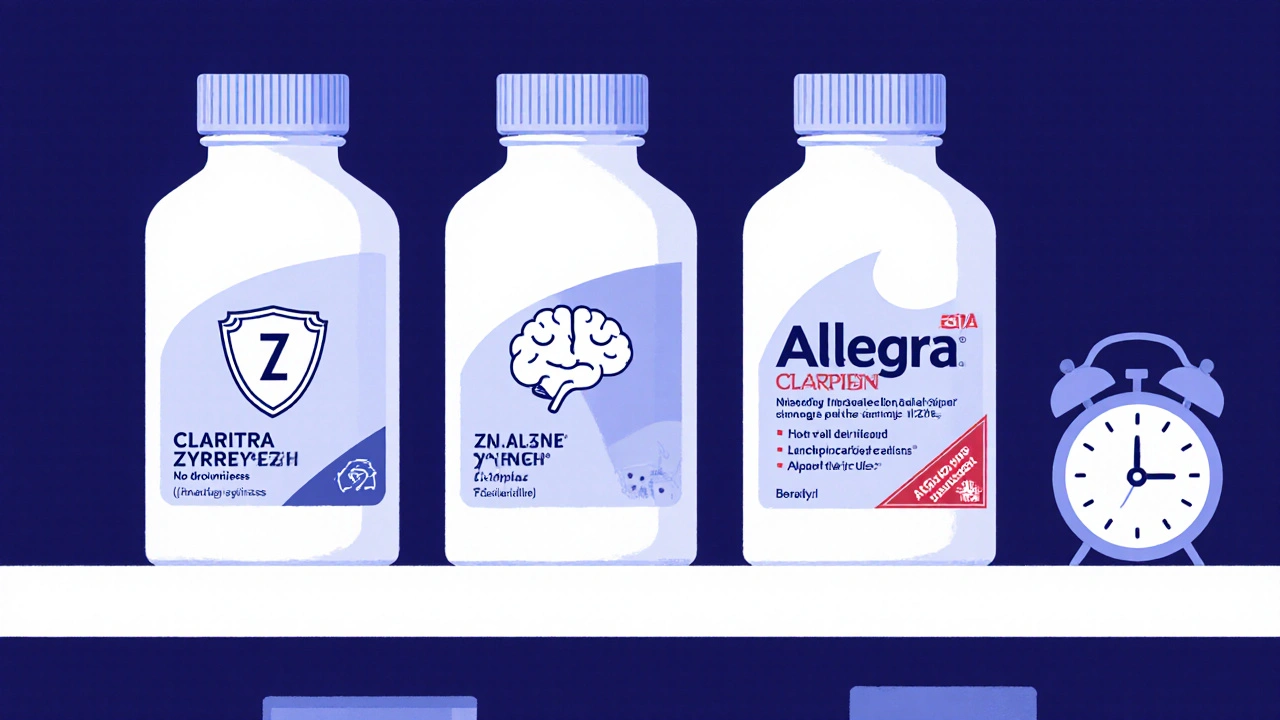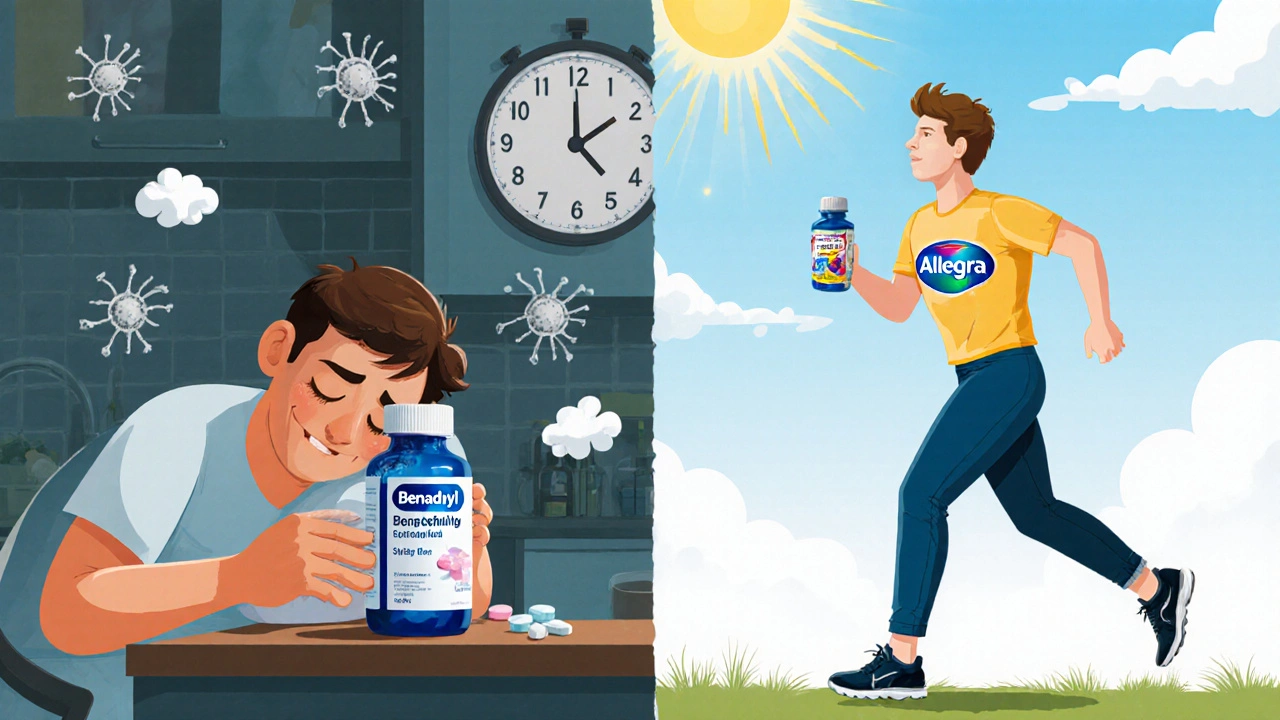Most people reach for an antihistamine when their nose starts running, eyes get itchy, or skin breaks out in hives. But not all antihistamines are the same. Some knock you out. Others let you drive, work, or pick up your kids without a second thought. If you’ve ever taken Benadryl at 3 p.m. and crashed by 4, you know the difference. The right choice isn’t just about what works-it’s about what works without wrecking your day.
What Antihistamines Actually Do
Antihistamines block histamine, a chemical your body releases during an allergic reaction. Histamine triggers sneezing, itching, runny nose, and watery eyes. These drugs don’t cure allergies-they just quiet the symptoms. They’ve been around since the 1930s, when French scientist Daniel Bovet first figured out how to stop histamine from causing trouble. Today, there are two main types: H1 blockers (for allergies) and H2 blockers (for stomach acid). You’re probably only using H1 blockers if you’re buying something off the shelf for sneezing or hives.First-Generation Antihistamines: The Sleepy Ones
These are the old-school options: diphenhydramine (Benadryl), chlorpheniramine (Chlor-Trimeton), doxylamine (Unisom), and promethazine (Phenergan). They work fast-sometimes in as little as 15 minutes. That’s why some people use them for sudden allergic reactions or even as a sleep aid. But here’s the catch: they cross into your brain easily. About half of people who take them feel drowsy. Studies show they can slow your reaction time like having a blood alcohol level of 0.10%. That’s legally drunk in most places.They’re not meant for daily use. Taking them every day for seasonal allergies? Bad idea. You’ll feel foggy, forgetful, and maybe even unsteady on your feet. The American Academy of Pediatrics warns against giving these to kids under six. Even adults over 65 are more sensitive to the effects. If you’re driving, operating machinery, or need to stay sharp, avoid these unless it’s an emergency.
Second- and Third-Generation Antihistamines: The Non-Sedating Options
These are the ones you’ll find in most OTC allergy aisles today: cetirizine (Zyrtec), loratadine (Claritin), fexofenadine (Allegra), levocetirizine (Xyzal), and desloratadine (Clarinex). They were designed to stay out of your brain. That means less drowsiness, more alertness, and 24-hour relief with just one pill.Not all of them are created equal, though. Fexofenadine (Allegra) has the lowest risk of drowsiness-only about 6% of users report feeling sleepy, according to clinical data. Cetirizine (Zyrtec) is effective but causes drowsiness in around 14% of people. Levocetirizine (Xyzal), which is the active part of Zyrtec, is slightly better than Zyrtec but still carries more sedation risk than Allegra. A 2021 study found that people taking Zyrtec showed measurable cognitive slowing, while those on Allegra didn’t.
Onset of action is similar across the board: most start working within an hour. But Allegra takes a little longer-about 1 to 2 hours-so don’t expect instant relief if you’re already sneezing. If you’re planning ahead, start taking them 1 to 2 weeks before allergy season hits. That gives your body time to build up protection before pollen levels spike.

Which One Should You Choose?
Here’s a simple guide based on your lifestyle:- Need to stay alert all day? Go with fexofenadine (Allegra). It’s the safest bet for truck drivers, surgeons, teachers, or anyone who can’t afford to nod off.
- Want maximum relief and don’t mind a slight chance of sleepiness? Cetirizine (Zyrtec) is strong. Many users swear by it for severe symptoms.
- Prefer a gentle, reliable option with a long track record? Loratadine (Claritin) has been around since the 90s. It’s less likely to cause drowsiness than Zyrtec and works well for most people.
- Over 65? Be cautious with Xyzal. Its OTC label doesn’t include adult dosing for people over 65 because of higher drowsiness risk. Stick with Claritin or Allegra unless your doctor says otherwise.
Some people need to try two or three before finding what clicks. About 30% of users don’t respond well to the first one they pick. That’s normal. Allergies are personal. Your body reacts differently than your neighbor’s.
What to Avoid
Don’t mix antihistamines with alcohol. It multiplies the drowsiness. Also, avoid grapefruit juice with fexofenadine (Allegra). It can raise the drug’s concentration in your blood by up to 37%, increasing side effect risks. Check labels for pseudoephedrine (a decongestant) if you have high blood pressure. Products like Allegra-D combine antihistamine and decongestant, which can raise heart rate and blood pressure.Also, don’t use first-generation antihistamines as a long-term sleep aid. They disrupt deep sleep cycles and can make insomnia worse over time. If you’re using Benadryl to fall asleep, talk to your doctor. There are better options.
Real People, Real Experiences
On Reddit’s r/Allergies community, users consistently say Allegra gives them “zero drowsiness-even at double doses.” Zyrtec gets mixed reviews: “Works great, but by 3 p.m. I’m useless.” Amazon reviews show Claritin with a 4.4/5 average, with 82% of 5-star reviews praising “no sleepiness.” Benadryl, meanwhile, has a 3.9/5 rating-with 63% of negative reviews saying it “knocked me out completely.”WebMD data shows users over 65 are nearly twice as likely to report unexpected drowsiness with Xyzal compared to younger users. That’s why the label doesn’t give dosing instructions for older adults-it’s not because it doesn’t work. It’s because the risk isn’t worth it without medical supervision.

When to Call a Doctor
Most OTC antihistamines are safe for short-term use. But see a doctor if:- Your symptoms don’t improve after 7 days
- You need to take antihistamines every day for more than a few months
- You’re pregnant, breastfeeding, or have liver or kidney disease
- You’re taking other medications-especially sedatives, antidepressants, or blood pressure drugs
- You experience heart palpitations, trouble urinating, or confusion
Chronic allergies might need more than pills. Allergy shots, nasal sprays, or biologic therapies could be better long-term solutions. The American College of Allergy, Asthma, and Immunology offers a free helpline (1-800-842-7777) and an online tool called the “Allergy Relief Finder” to help match symptoms to the right treatment.
What’s New in 2025
The market is shifting. Non-sedating antihistamines now make up 78% of the OTC allergy market in the U.S. Claritin, Zyrtec, and Allegra together control over 78% of sales. New formulations are coming: Sanofi plans to launch a rupatadine nasal spray in 2024, and a new extended-release Allegra-D combo now gives 12-hour decongestant relief alongside 24-hour allergy control.Research is also looking at long-term risks. A 2022 JAMA study found a possible link between chronic use of first-generation antihistamines and higher dementia risk in people over 75. But there’s no evidence that second-generation drugs like Claritin or Allegra carry the same risk. Still, if you’re over 70 and taking Benadryl daily, it’s time to talk to your doctor.
Bottom Line
You don’t need to suffer through allergy season. But you also don’t need to be a zombie. Stick with second- or third-generation antihistamines-Allegra, Claritin, or Zyrtec. Avoid the old-school sleepers unless it’s an emergency. Start early, take them consistently, and listen to your body. If one doesn’t work, try another. Your best option isn’t the most popular one-it’s the one that lets you live your life without side effects.Can I take antihistamines every day?
Yes, second- and third-generation antihistamines like loratadine, cetirizine, and fexofenadine are safe for daily use, even for months at a time. They’re designed for long-term allergy management. First-generation antihistamines like Benadryl are not recommended for daily use due to sedation and cognitive side effects. If you’re taking any antihistamine every day for more than 3 months, check in with your doctor to make sure it’s still the best option.
Is Allegra better than Zyrtec?
It depends on what you need. Allegra (fexofenadine) causes less drowsiness-only about 6% of users report it, compared to 14% for Zyrtec (cetirizine). If you’re a driver, a parent, or someone who can’t afford to feel sleepy, Allegra is the safer pick. Zyrtec is stronger for severe symptoms, but you might pay for it with afternoon fatigue. Both work equally well for itching and runny nose. Try one for a week, then switch if needed.
Why does my antihistamine stop working after a few weeks?
It’s not that the drug stopped working-it’s that your allergies got worse. Allergies aren’t static. Pollen counts rise, new triggers appear, or your body adapts. If your symptoms return, try switching to a different antihistamine. About 30% of people need to try two or three before finding the one that fits. You can also combine it with a nasal steroid spray for better control.
Can children take OTC antihistamines?
Second-generation antihistamines like loratadine and cetirizine are approved for children as young as 2, but always check the label for age-appropriate dosing. First-generation antihistamines like Benadryl are not recommended for children under 6 due to safety risks. For kids, use the liquid form and a proper measuring tool-never guess the dose. If your child has chronic allergies, talk to a pediatric allergist.
Do antihistamines cause weight gain?
Some users report weight gain, especially with cetirizine (Zyrtec). While not proven in large studies, histamine plays a role in appetite regulation. Blocking it might increase hunger in some people. Fexofenadine (Allegra) and loratadine (Claritin) are less likely to have this effect. If you notice unexplained weight gain, switch antihistamines or talk to your doctor.
Can I take antihistamines with high blood pressure?
Only if they don’t contain decongestants. Products like Allegra-D, Claritin-D, or Zyrtec-D include pseudoephedrine, which can raise blood pressure and heart rate. Stick to plain antihistamines-Allegra, Claritin, Zyrtec without the “-D.” Always check the label. If you’re unsure, ask your pharmacist or doctor before taking anything.
If you’re managing allergies on your own, you’re not alone. Over 50 million Americans deal with seasonal allergies every year. The right antihistamine can turn suffering into just another day. Choose wisely, listen to your body, and don’t be afraid to switch if something isn’t working. Your alertness matters as much as your sneezing.

Comments (9)